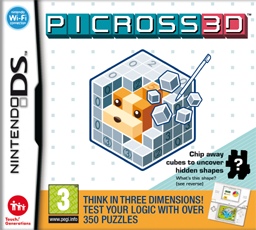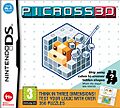Picross 3D facts for kids
Quick facts for kids Picross 3D |
|
|---|---|

European cover
|
|
| Developer(s) | HAL Laboratory |
| Publisher(s) | Nintendo |
| Director(s) | Yoshiki Suzuki Teruyuki Gunji |
| Producer(s) | Kensuke Tanabe Yoichi Yamamoto Masayoshi Tanimura |
| Artist(s) | Benimaru Itoh |
| Writer(s) | Kenichi Masuda |
| Composer(s) | Yasumasa Yamada Jun Ishikawa Hirokazu Ando |
| Platform(s) | Nintendo DS, Wii U |
| Release date(s) | Nintendo DS
|
| Genre(s) | Puzzle |
| Mode(s) | Single-player |
Picross 3D is a fun puzzle video game made by HAL Laboratory and published by Nintendo. It came out for the Nintendo DS system. In Japan, it's known as Rittai Picross, which means "Solid Geometry Picross."
The game first launched in Japan in March 2009. It then came to Europe in March 2010 and North America in May 2010. Picross 3D is like other Picross games, but it adds a cool 3D twist! A sequel, Picross 3D: Round 2, was later released for the Nintendo 3DS.
Contents
How to Play Picross 3D
In Picross 3D, you start with a big block made of many smaller cubes. Your goal is to chip away the extra cubes to reveal a hidden 3D picture inside. It's like sculpting, but with numbers guiding you!
Understanding the Cube Clues
Each row and column of cubes has numbers. These numbers tell you how many cubes should be left in that line to form the picture.
- If a number has a circle around it, it means the cubes in that line will be in two separate groups. For example, a circled 4 could mean groups of 1 and 3 cubes, or 2 and 2 cubes.
- If a number has a square around it, the cubes will be in three or more groups.
- If there's no number, there are no special rules for that row or column.
Tools for Solving Puzzles
You have two main tools to help you solve the puzzles:
- A paintbrush lets you mark cubes that you know are part of the final picture. This helps you remember them and stops you from accidentally breaking them.
- A hammer is used to chip away cubes that you think are not part of the picture. Be careful! If you try to break a cube that *is* part of the image, you'll get a "strike."
You can only get five strikes before you have to start the puzzle over. You also need to finish each puzzle within a certain time limit. The game gives you helpful "technique" tutorials to make you a better puzzle solver.
Rewards and Challenges
When you finish a 3D image, you'll see a short animation of your creation. The image then goes into a special collection. Try to complete all the collections!
In standard puzzles, you can earn up to three stars. You get more stars for finishing quickly and without any mistakes. These stars unlock extra puzzles.
There are also special challenges:
- One-Chance Challenges mean you're out if you make even one mistake.
- Time Challenges make you chip away cubes fast to keep adding time to your clock.
- Construction Challenges involve solving several puzzles to build one giant image.
You can also unlock bonus animations by completing puzzles on different difficulty settings.
Sharing and Creating Puzzles
Before 2014, players could download new puzzles using the Nintendo Wi-Fi Connection. You could also create your own puzzles and share them with friends or enter them into online challenges.
Even though the Nintendo Wi-Fi Connection is no longer active, you can still send and receive puzzles locally with friends using wireless transfer.
Images for kids


